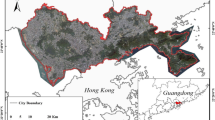Abstract
This work presents an approach for classifying urban blocks according to their built-up structure based on high-resolution spaceborne InSAR images. Most attributes considered in the classification describe the geometric structure and spatial disposition of the polygon and line features extracted from each block. The feature extraction is carried out on two intensity images acquired at the satellite’s ascending and descending orbits. The strategy used for extracting polygon features is described in detail. We also present a Markov random field model used to perform context-based classification of built-up structures. The model establishes a probabilistic dependency between the class labels of two neighbouring blocks, taking in this way advantage of the fact that blocks with the same structure are frequently clustered. 1695 urban blocks were classified into five general built-up types. It is shown that the context-based classification accuracy is up to 6% more accurate than the standard classification on which the context-based model is based. We hence provide evidence (1) that urban block-based classifications can potentially be improved if context is considered and (2) that general built-up structures can be distinguished to a good extent using available high-resolution spaceborne radar images.
Zusammenfassung
Kontextbasierte Klassifizierung von Baublöcken aufgrund ihrer Baustruktur. Wir präsentieren einen Ansatz zur Klassifizierung von Baublöcken bezüglich ihrer Stadtstrukturtypen, welcher auf hochaufgelösten InSAR-Satellitenbildern basiert. Baublöcke werden dabei über linienhafte und polygonale Strukturen (Features) beschrieben, wobei deren geometrische Strukturen und räumliche Verteilungen berücksichtigt werden. Die Extraktion dieser Features basiert hierbei auf zwei Intensitätsbildern, die jeweils aus gegenläufigen Aufnahmerichtungen aufgenommen wurden (ascending vs. descending). Darüber hinaus wird ein Markov-Random-Field-Modell zur kontext-basierten Klassifizierung verwendet. Dieses Modell basiert auf der Annahme probabilistischer Abhängigkeiten zwischen den Klassen benachbarter Blöcke, was aufgrund oft gleichartiger Baustruktur in unmittelbarer Nachbarschaft gerechtfertigt erscheint. In dieser Studie werden 1.695 Baublöcke zu fünf Klassen zugewiesen. Die Berücksichtigung des Block-Kontextes hat dabei verglichen mit einem konventionellen Random-Forest-Modell zu einer Verbesserung der Klassifizierungsgenauigkeit von 6% geführt. Die erzielten Ergebnisse zeigen zwei wesentliche Erkenntnisse auf: a) die Möglichkeit der Klassifizierung von Stadtstrukturtypen anhand hochaufgelöster, satellitengestützter InSAR-Bilder, sowie b) die wesentliche Verbesserung der Klassifizierungsergebnisse unter Einbezug der lokalen kontextuellen Informationen.







Similar content being viewed by others
References
Bengston D-N, Fletcher J-O, Nelson K-C (2004) Public policies for managing urban growth and protecting open space: policy instruments and lessons learned in the United States. Landsc Urban Plan 69(2–3):271–286
Benz UC, Hofmann P, Willhauck G, Lingenfelder I, Heynen M (2004) Multi-resolution, object-oriented fuzzy analysis of remote sensing data for GIS-ready information. ISPRS J Photogram Remote Sens 58(3–4):239–258
Breiman L (2001) Random forests. Mach Learn 1:5–32
Chen Z,-Z, Guindon B, Esch T, Roth A, Shang J (2012) Urban land use mapping using high resolution SAR data based on density analysis and contextual information. Can J Remote Sens 38(6):738–749
Dalal N, Triggs B (2005) Histograms of oriented gradients for human detection. In: IEEE computer society conference on computer vision and pattern recognition, vol 1, pp 886–893
Douglas D-H, Peucker T-K (1973) Algorithms for the reduction of the number of points required to represent a digitized line or its caricature. Cartographical: Int J Geogr Inf Geovisualization 10:112–122
Duda R-O, Hart P-E (1972) Use of the Hough transformation to detect lines and curves in pictures. Commun ACM 15:11–15
Frey B-J, Josic N (2005) A comparison of algorithms for inference and learning in probabilistic graphical models. IEEE Trans Pattern Anal Mach Intell 27:1–25
Galamhos C, Matas J, Kittler J (1999) Progressive probabilistic Hough transform for line detection. In: IEEE computer society conference on computer vision and pattern recognition, vol 1, pp 554–560
Heiden U, Heldens W, Roessner S, Segl K, Esch T, Mueller A (2012) Urban structure type characterization using hyperspectral remote sensing and height information. Landsc Urban Plan 105(4):361–375
Kirsch R (1971) Computer determination of the constituent structure of biological images. Comput Biomed Res 4:315–328
Koller D, Friedman N (2009) Probabilistic graphical models: principles and techniques, 1st edn. MIT Press, London, p 1231
Kschischang F, Frey B, Loeliger H (2001) Factor graphs and the sum-product algorithm. IEEE Trans Inf Theory 47:498–519
Myint S (2001) A robust texture analysis and classification approach for urban land-use and land-cover feature discrimination. Geocarto Int 16(4):29–40
Myint S, Gober P, Brazel A, Grossman-Clarke S, Weng Q (2011) Per-pixel vs. object-based classification of urban land cover extraction using high spatial resolution imagery. Remote Sens Environ 115:1145–1161
Novack T (2016) Context-based classification of urban structure types using spaceborne InSAR images. PhD dissertation, Technische Universitaet Muenchen
Novack T, Kux H, Feitosa R, Costa G (2014) A knowledge-based, transferable approach for block based urban land-use classification. Int J Remote Sens 35:4739–4757
Otsu N (1979) A threshold selection method from grey-level histograms. IEEE Trans Syst Man Cybern 9(1):62–66
Patino J, Duque J (2013) A review of regional science applications of satellite remote sensing in urban settings. Comput Environ Urban Syst 37:1–17
Pauleit S, Duhme F (2000) Assessing the environmental performance of land cover types for urban planning. Landsc Urban Plan 52(1):1–20
Salembier P, Oliveras A, Garrido L (1998) Antiextensive connected operators for image and sequence processing. IEEE Trans Image Process 7:555–570
Soergel U (2010) Review of radar remote sensing on urban areas. In: Soergel U (ed) Radar remote sensing of urban areas, 1st edn. Springer, Dordrecht
Stilla U (2007) High resolution radar imaging of urban areas. In: Fritsch D (ed) Photogrammetric Week 07. Wichmann, Heidelberg
Thomas I, Frankhauser P, Biernacki C (2008) The morphology of built-up landscapes in Wallonia (Belgium): a classification using fractal indices. Landsc Urban Plan 84:99–115
Tobler W (1970) A computer movie simulating urban growth in the Detroit region. Econ Geogr 46:234–240
Walde I, Hese S, Berger C, Schmullius C (2014) From land cover-graphs to urban structure types. Int J Geogr Inf Sci 28:584–609
Woodhouse I (2006) Introduction to microwave remote sensing, 1st edn. Taylor and Francis, Boca Raton, p 400
Author information
Authors and Affiliations
Corresponding author
Rights and permissions
About this article
Cite this article
Novack, T., Stilla, U. Context-Based Classification of Urban Blocks According to Their Built-up Structure. PFG 85, 365–376 (2017). https://doi.org/10.1007/s41064-017-0039-7
Received:
Accepted:
Published:
Issue Date:
DOI: https://doi.org/10.1007/s41064-017-0039-7




